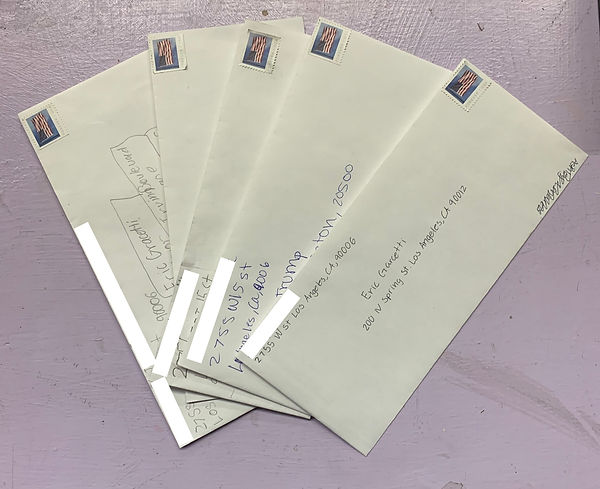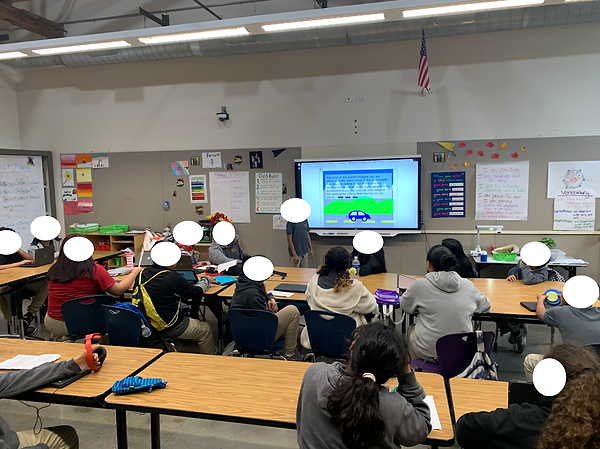Advocacy in Action
Letters to an Elected Offical
I developed a brief unit for my students that required them to become advocates and demand change from an elected official. My students used their collective assets to collaboratively write letters that contain factual evidence and personal stories that advocate for change. My students mailed their letters to an elected official of their choice, hopefully, if enough constituents hold a similar opinion, the official will read the compelling letters and take action to make a difference.
This unit took 5 instructional days to complete. For all of my 6th-grade students, this was the first letter that they had written. To make this unit accessible for all of my students I had to chunk the learning activities and create different roles that allowed students to select a role that best fits their strengths. The objectives are as follows: day 1 students select a topic to write their letter about, day 2 students read and gather evidence, day 3 and 4 students drafted their letters in collaborative groups using their collective assets to tackle a systematic injustice in this country, day 5 students peer-reviewed their letters and then they printed them, placed them in an envelope, and addressed their envelope to the elected official they selected. Once students handed me their letters they completed the last task, a reflection.
This artifact contains my slideshow presentation for this unit. The presentation contains a Do Now, an overview of the project, a series of videos about real-world problems and systemic injustices in the United States, and group member directions. Creating group member roles was essential for the success of this project. This project was a daunting task for my 6th graders but by chunking the activities and providing roles it made the project manageable. The group member roles encouraged my students to use their individual assets and create a letter that demonstrates a collective effort. Each role used a different strength role 1: formal writing role 2: researching role 3: storytelling role 4: graphic design.
This artifact is four student work samples of the Letter to an Elected Offical worksheet. This worksheet chunked the letter-writing process; students had to read through two pre-selected articles and gather evidence for their letter. Once students completed their evidence they made a personal connection to their topic. These two tasks align with sections in the letter the students drafted the next day. Each real-world problem students identified: climate change, drug epidemic, and mental health stems from systemic injustice and disproportionately affects persons of color.
In my google classroom, I created a document that had a long list of systemic injustices and real-world problems my students could write their letter about. Each systemic injustice had three articles that my students were required to read. Students conducted research to develop an informed opinion on a systemic injustice they were passionate about. My students used their research-informed opinions as they worked collaboratively to draft their letters. My students used the power of their voices to ask our political leaders for change.
My students wrote letters about the following systemic injustices:
The Drug Epidemic: In 2017 alone more than 70,000 people died of an overdose (Center for Disease Control, n.d.). In 2018 there were four times more drug overdose deaths in the United States that there were in 1999. The United States is currently experiencing its third wave of opioid overdoses, this wave is marked by the introduction of the highly deadly chemical fentanyl (Center for Disease Control, n.d.). This is a problem that is prevalent in Los Angeles where my students live, the lead third leading cause of death in injury-related/premature deaths in Los Angeles County (Los Angeles Country Department of Public Health, 2013).
The Hunger Crisis: In 2019 12.5 million children in the United States experienced hunger and food insecurity. This problem is also prevalent on college campuses with 40% of undergraduates experiencing food insecurity (Pederson, 2013). This a problem that my students experience often, in Los Angeles, one in five residents may not know when their next meal is coming, with an estimated 2 million residents who are experiencing food insecurity (Riches, 2014).
The Climate Crisis: The last four years (2015-2019) have been the hottest years on record (United Nations, 2020). Human activity is driving the temperature to rise at an alarming rate, as the average temperature increases it will have devastating consequences for life on Earth. People of color will be disproportionately affected by the climate crisis. Currently in the United States people of color are 40% more likely to breathe in polluted area than white people, this difference will increase a climate change becomes more serious (Green America, n.d.). Additionally, people of color are more likely to live near toxic sites. While Black people make up 13% of the population 68% of Black people live within a 30-mile radius of a coal mine. The climate change crisis is a particular concern in Los Angeles where rising sea levels will dramatically reshape the city.
This student group demonstrated the ability to use their collective assets to draft a compelling letter advocating for change. The student group provided three pieces of factual evidence, a personal connection to the drug epidemic, and asked for reform in three specific ways. The letter was placed in the mail on 03/06/2020 my students and I are patiently awaiting a response from the mayor.
This letter was written by a 6th grade English Language Learner who has an IEP. Extended writing responses have been a challenge for him all year. He was successful during this unit because the activities were chunked, he was provided with a template, he relied on his group members' collective assets, and lastly, he was very passionate about this topic given his personal experience with hunger. This letter provided less specific action steps to prevent hunger in the United States but it provides the president with compelling evidence and a personal connection to the topic.

In total, my students wrote five letters each addressing a different elected official: Mayor Eric Garcetti, Congressman Ted Lieu, or President Donald Trump. My students wrote about real-world problems that stem from systemic injustices in the United States. My students wrote about climate change, mental health, the drug epidemic, hunger, and gun violence. The letters were mailed to the elected officials on 03/06/2020 and we are patiently waiting for a response from the respective parties.
This artifact is four student work samples containing my students' reflections after writing and mailing their letters. The reflections demonstrate that my students have a sensitivity and awareness of the world around them and the injustices present. In two of the reflections, my students specifically mention how their topic disproportionately affects persons of color. The reflections show that my students are passionate about change and furthermore that my students know how to use their collective assets to advocate for change on a variety of issues. I hope that these letters are starting point for the change that my students will lead and cause.
Climate Change Presentation
In my coding class I developed a unit that positioned my students as climate change advocates. This project was inspired by Greta Thunberg who is a symbol for youth activism and climate change. My students developed climate change crisis presentations using coding technology. My students became advocates by expanding their message to a larger audience; my students presented their stories to 7th and 8th grade science. My students used their individual assets to develop a story that brings awareness to climate change which is a systemic inequality that will disproportionately people of color and people of low socio-economic status. My students stories brought awareness to climate and also provided audience members with action steps that they can take to reduce their impact on climate change.
This climate change unit lasted approximately 2 weeks and served as my students' culminating task for quarter 2. The lesson plan demonstrates how I provided my students with a scaffolded approach to complete the task of coding a story. This lesson was accessible for my English Langauge Learners because they could modify the language on CS First and Scratch to their primary language. By the end of the lesson my students became climate change advocates.
This artifact is my slideshow presentation for my climate change unit. The presentation contains a video of Greta Thunberg my inspiration for the project, daily Do Nows, an overview of the project, and an agenda.
This artifact contains my handouts for the climate change unit. The first handout is the Before the Flood Worksheet, followed by the climate change quiz, climate change checklist, and climate change presentation scoring sheet. My students used the Before the Flood worksheet and climate change quiz as a source of evidence as they coded their stories. Due to COVID-19 and my school's closure, I am unable to provide PDFs of my students' completed hand outs.

This is a 6th-grade student advocating for climate change to a 7th-grade science class. The student is showing the class his climate change story he coded using Scratch. The student used his individual assets to tackle the system injustice of climate by bringing awareness to the issue and providing his schoolmates with action steps that they can take to reduce their impact on climate change.
Below are three student work samples from the Climate Change Presentation project. Each project was completed by a 6th-grade student and took a minimum of two hours to code. Please click the links below to view my students' presentations.
https://scratch.mit.edu/projects/350483330
This 6th-grade student created a powerful presentation underscored by emotional music and many scene changes.
https://scratch.mit.edu/projects/347384171
This 6th-grade student utilized many scene changes and incorporated thorough research on climate change throughout her presentation.
https://scratch.mit.edu/projects/347382074
This 6th-grade student created a compelling presentation on climate change by combining music and before and after pictures of Earth to demonstrate the destructiveness of climate change.
Each student addresses the amount of time and effort that was required to code their interactive climate change stories. The students briefly discuss the experience of presenting their project to their peers and classmates, one student wished he could share his presentation with other classes. In the third reflection, the student identifies how climate change is a systematic injustice by explaining that it will disporprotionately affect people of color.
References
Center for Disease Control. (2020, March 24). America's Drug Overdose Epidemic - Data to Action. Retrieved from https://www.cdc.gov/injury/features/prescription-drug-overdose/index.html
Green America. (n.d.). People of Color Are on the Front Lines of the Climate Crisis. Retrieved from https://www.greenamerica.org/climate-justice-all/people-color-are-front-lines-climate-crisis
Los Angeles County Department of Public Health. (2013). Prescription Drug Abuse in Los Angeles County. Retrieved from http://publichealth.lacounty.gov/docs/HealthNews/PrescriptionDrug-12-13.pdf
Pedersen, Traci (August 13, 2019). "Food Insecurity Common Among US College Students". Psych Central. Retrieved November 23, 2019.
Riches, Graham. (2014, October 19). "American Shame". New York Times. Retrieved March 20, 2020.